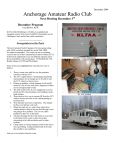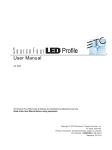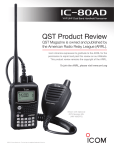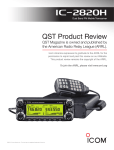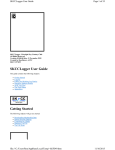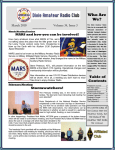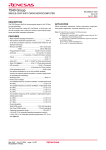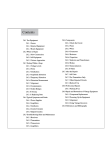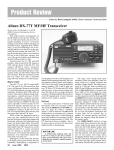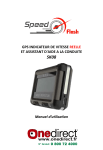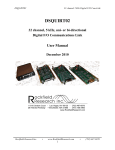Download ARASWF Newsletter – April, 2015
Transcript
ARASWF Newsletter Vol. MMXV No. 4 - The Journal of the Amateur Radio Association of Southwest Florida April 15, 2015 In This Issue: Nickels & Dimes Board Meeting Minutes Membership Meeting Minutes Upcoming Contest Calendar News Articles Upcoming Events The next Club Meeting will be held April 28th 2015 at 7:00pm at the Red Cross - 2610 Northbrooke Plaza Drive Naples, FL Nickels & Dimes You are reading this a week later than normal because I spent last week swimming with the fish in Cayman Brac, decompressing from a big project here at Foxfire that had sucked most of the ‘air’ from my tank. I’m almost back to normal… While I was away, Uli held a D-Star workshop. Judging from a number of email responses, I’m sure it was helpful and well attended. While many other digital modes exist today and are readily available for local VHF/UHF repeater systems, none offer a better US or Worldwide integrated network then D-Star provides. Our Club has a tremendous resource here in Naples and many snowbirds have discovered and utilize it to contact their northern friends while visiting here in Naples… you might remember, with D-Star it’s easy to monitor their usage and activity. Hopefully, the D-Star Workshop will attract a few more members and local users into the D-Star community. Many inexpensive, used radios are available on eBay or QTH http://swap.qth.com/ …give it a try! Also, the Florida QSO Party is next weekend – April 25-26th. Plan to stop by the Red Cross and give Mark-AC4ZM some help manning one of the four radios. This year, there will be a bonus point spelling bee. The objective is to work all six 1x1 special event stations that spell out O-R-A-N-G-E, these stations include: K4O, K4R, K4A, K4N, K4G, and K4E. Why ORANGE? It is one of the official colors of the Florida Contest Group (FCG) the sponsor of the Florida QSO Party. FCG was started many years ago by Jim White-K4OJ (SK), hence orange and white club colors. Many FCG members include OJ in their email signature, as a show of respect to Jim, widely known as OJ in the contest community. 2015 Field Day – It’s not too soon to start thinking about Field Day - June 27-28th. Larry-KC8JCB has volunteered to chair this year’s project. Please consider helping make this another great event. Several areas need work including publicity, setup, operations, and food to name a few. If you would like to lead one of these areas, again please contact Larry. [email protected] As you can tell, there is not a straight line connecting all my thoughts this month, apparently I’m still off gassing nitrogen from last week. Hope to see you at the next meeting. This month Dr. Bill-K2ZEL will provide us a presentation on microprocessors. This topic resonated with many members who responded to the interest survey. Ken-W9KB ARASWF Secretary/Treasurer Amateur Radio Association of Southwest Florida Executive Board Meeting held at Apollo, Naples, FL Tuesday, March 17, 2015 Present: Uli Altvater, AGX – President Ken Bills, W9KB – Secretary/Treasurer Mark Harms, AC4ZM – Director Dave Ducett, WB8VQU – Director Gary Lee, K8YMN – Director Larry Kielasa, KC8JCB – Director Absent: Eric Gissendaner, KF4IXA – Vice President MEETING MINUTES Meeting called to order: The meeting was called to order at 7:00 pm. President’s Report – Uli-AGX welcomed the Board and gave a brief update. Treasurer’s Report – Ken-W9KB reported that the Club checking account had a current balance of $5,394.99. Expenses for the month included $30 T-Mobile, $60.18 - Oil Well Food, $80.20 - AllStar Network Adaptor, $32.00 - N-Connectors, and $58.41 for new bank checks. The Club received a $62 donation in-kind for the PO Box renewal, a $16 refund from Hayes Insurance (equipment), and $62 from the February meeting 50/50 raffle. Old Business: Uli-AG0X reported the WB2QLP AllStar node was up and running properly. The Board discussed adding a second AllStar node at the Ave Maria site (AD4SW) that would allow student and facility to utilize inexpensive 2m handhelds to communicate. Ken-W9KB agreed to contact Paul-KK4TPO regarding website updates. Several areas on the website need updating. (Editor’s note: Several changes were made, please visit and comment) Mark-AC4ZM reported that Rich-K4AOR ran a successful event held February 21st. Attendance was very good and the weather was perfect. The Board sends kudos to Rich and everyone who helped with the event. -2- Mark-AC4ZM reported that the Collier County local area ARES CERT groups will conduct a simulated emergency test (SET) exercise on March 21st in North Naples. Location and specific details will be published in the March Alert Newsletter. Mark encouraged all those members interested in EmComm to attend. New Business: The Board discussed several ideas and locations for a summer luncheon meeting. Larry-KC8JCB agreed to look at a few restaurants and propose a suitable location at the next Board meeting. Dave-WB8VQU reported on a proposed field trip to the “America Victory” a retired Navy ship that is available for tours in the Tampa Bay. Dave agreed to discuss the details at the next meeting and determine the level of Club interest. http://www.americanvictory.org/ Larry-KC8JCB agreed to chair the 2015 ARRL Field Day. Last year’s successful event will help serve as a model. The Saturday afternoon BBQ was a highlight that Tim-KC4SSD ably handled. The Board discussed at set the agenda for the next membership meeting. Specific assignments that were taken out of the meeting: KC8JCB – Locate suitable summer Club lunch venue(s) WB8VQU – Check out “American Victory” schedule and cost AC4ZM – Develop membership brochure layout W9KB – Deliver Club AllStar computer to K8YMN for Ave Maria setup Next Board Meeting – April 21st 7:00pm at Apollo (AG0X business QTH) Adjournment: The meeting was adjourned at 8:35 pm. Respectfully submitted, Ken Bills, W9KB Secretary Amateur Radio Association of Southwest Florida Regular Membership Meeting held at the Naples American Red Cross. Tuesday, March 24, 2015 Officers and Directors present: Uli Altvater, AG0X – President Eric Gissendaner, KF4IXA – Vice President Ken Bills, W9KB – Secretary/Treasurer Mark Harms, AC4ZM – Director Gary Lee, K8YMN – Director Larry Kielasa, KC8JCB - Director Dave Ducett, WB8VQU – Director Absent: None Meeting called to order: Uli-AGOX called the meeting to order and opened it with the Pledge of Allegiance. Introduction: All attendees were introduced by name and call sign, also an attendance sheet was passed for all to sign-in. 34 members were in attendance and one guest, Richard Varnes. Treasurer’s Report: Ken-W9KB reported that Club checking balance was $5,394.99 including $128 in receipts for the month. Expenses were $260.79 for the month including, Oil Well food, AllStar Network adaptor, and misc. antenna connectors. Old Business: Uli-AG0X reported that the Marbella site is working properly, a few minor adjustments might be necessary. Uli reported that K5MI (Macro Island D-Star 146.985 mHZ) is back on the air after he made a site visit with Jim-K3AVR. Uli reported that the Board supported removing D-Star from the Ave Maria repeater and adding AllStar which should make it more accessible to the students and facility with low cost HT’s. Ed-K1UQE provided an updated EmComm report of this past month’s activities. The next meeting with the county is March 26th 2:00pm and the EOC facility. Ed reported that the Collier County CERT event held last weekend was well attended by 12 members from our Club. The event was a simulated emergency test (SET) that involved a school bus accident and several injured passengers. Several local area CERT teams conducted their drills which involved first containing the site and then removing passengers, while his EmComm team provided communication support. Mark-AC4ZM also reported he had one successful VE candidate this month, Richard Varnes who passed his Technician exam. Congratulations Rich! New Business: Mark-AC4ZM will chair a team of operators for the Florida QSO Party, to be held April 25 & 26th. A four radio station will be set up at the Red Cross, all members are encouraged to stop by and operate for a few hours. The station will be on the air Saturday from noon until 10pm and then again on Sunday from 8am until 6pm Mark also reported he will conduct a follow-up Digital School workshop at the Red Cross on Saturday May 9th from noon until 2pm. If you missed an earlier session, this is a great opportunity to test and improve your digital mode communication skills. Larry-KC8JCB announced that he would chair this year’s Field Day. He is looking for help and will schedule a committee meeting(s) as we get closer to June. This year’s venue, the Red Cross has been reserved for the event. Uli-AG0X reported some of the Marco Island Radio Club (MIRC) members had requested he hold a D-Star Workshop to help them better understand the technology. He polled the Club members present to get a sense of whether to hold the workshop at the Marco Civil Air Patrol (CAP) or the Naples Red Cross location. A show of hands reveled a fairly even split, so it was decided to hold the workshop at the Marco CAP on April 11th. Since the request came from MIRC members. (Editor’s note: the Marco CAP was not available on that date, so it was held instead at the Red Cross on April 11th). Karl-N1DL reported that while he has moved from the Dunes, AC4FL (443.275 mHZ) will continue to operate from that location. Free Internet and its high antenna location make this a very useful D-Star link into Lee County. 50/50 Raffle ($79) was won by Richard Varnes. Social Break: 20 minutes Presentation: Dr. Al Torres-KP4QAI gave his third and final lecture of the season before migrating back to Dayton, OH. This month Dr. Al explained mysteries of VHF/UHF propagation and the importance of antenna height, polarization, and ‘space’ losses. He developed an analytical model to predict communication path distances in terms of these factors and others which he explained at length. These factors all have a significant impact on reliable point-to-point communications. Adjourn: Motion to adjourn meeting at 9:02 p.m. made and seconded. Motion passed by all present. Respectfully submitted, Ken-W9KB, Secretary Contest Calendar April 2015 + Michigan QSO Party + Ontario QSO Party + YU DX Contest + Run for the Bacon QRP Contest + SKCC Sprint + CWops Mini-CWT Test + 10-10 Int. Spring Contest, Digital + SP DX RTTY Contest + Helvetia Contest + Florida QSO Party 1600Z, Apr 18 1800Z, Apr 18 2100Z, Apr 18 0100Z-0300Z, 0000Z-0200Z, 1300Z, Apr 22 0001Z, Apr 25 1200Z, Apr 25 1300Z, Apr 25 1600Z, Apr 25 May 2015 + AGCW QRP/QRP Party + 10-10 Int. Spring Contest, CW + ARI International DX Contest + 7th Call Area QSO Party + Indiana QSO Party + Delaware QSO Party + New England QSO Party + VOLTA WW RTTY Contest + CQ-M International DX Contest + SKCC Weekend Sprintathon + FISTS Spring Sprint + CWops Mini-CWT Test + His Maj. King of Spain Contest, CW + Run for the Bacon QRP Contest + Baltic Contest + SKCC Sprint + CWops Mini-CWT Test + CQ WW WPX Contest, CW 1300Z-1900Z, May 1 0001Z, May 2 to 2359Z, May 3 1200Z, May 2 to 1159Z, May 3 1300Z, May 2 to 0700Z, May 3 1600Z, May 2 to 0400Z, May 3 1700Z, May 2 to 2359Z, May 3 2000Z, May 2 to 2400Z, May 3 1200Z, May 9 to 1200Z, May 10 1200Z, May 9 to 1159Z, May 10 1200Z, May 9 to 2359Z, May 10 1700Z-2100Z, May 9 1300Z, May 13 to 0400Z, May 14 1200Z, May 16 to 1200Z, May 17 0100Z-0300Z, May 18 2100Z, May 23 to 0200Z, May 24 0000Z-0200Z, May 27 1300Z, May 27 to 0400Z, May 28 0000Z, May 30 to 2400Z, May 31 to 0400Z, to 1800Z, to 1700Z, Apr 20 Apr 22 to 0400Z, to 2359Z, to 1200Z, to 1259Z, to 2159Z, Apr 19 Apr 19 Apr 19 Apr Apr Apr Apr Apr 23 26 26 26 26 Topics of Interest Twelve members attended the Annual CERT SET exercise on March 21, 2015. The ICS field command used the ARES amateur hams as primary communications for the exercise. Off-site net control was setup and on-site check points were assigned as needed. There were four CERT teams that worked thru the exercise as we relayed the information to ICS command. Saturday, May 9, 2015 from 12 noon to 2:00 pm is a scheduled Digitally Schooled Sessions at the American Red Cross. FLdigi with FLmsg and MMSSTV is the software of choice for digital emergency communications for our group. The session will cover configure review, macro mania, FLmsg, and MMSSTV operations. Our County is rather large and we plan to hold a special communications exercise in August instead of a meeting at the EM building. These portable simplex exercises will test our ability to contact each other near the corners of the County. We still do not have a time and date for a Tour of the Palmetto Ridge Special Needs Shelter. Please complete the F.E.M.A. ICS 100, 200, 700, and 800 on line training. This will help one understand and work thru the QRM; and to understand how the served agency functions. Goggle to find and download the following PDF “D-Star” radio manuals; ICOM ID-5100 will be at the E.O.C. (Check Point HQ) ICOM ID-2820 is at the P.R.H. (Check Point Hotel-1) It is a good thing to know how to use these radios. Thank You MARK HARMS AC4ZM AEC IDE – Integrated Development Environment The Art of Doing Something Useful with a Micro Controller by Dr. Bill Reynolds The IDE is the area where one sets up the programming, simulation, and testing of an embedded controller and the associated peripheral components to perform the desired task in an efficient and reliable manner. The heart of the environment is the selected micro-controller unit with programming application that will run on the common microcomputer systems. The development environment concept is not “a new or improved idea” but rather has been around the academic and industrial world in R&D departments. When the earliest microprocessor chips made their debut outside the laboratory, they were referred to as “central processing units” (nomenclature holdover from mainframe environment) and required significant support and peripheral chips to be embedded into useful controllers. The chip manufacturers made available to the academic and engineering communities sets of chips with and without development boards and said to these people “What can you do with this chip set?”. Three examples; 1) a controller for the bending magnet of the linear accelerator (in turn controlled by the PDP computer), 2) the control to the rocking x-ray spectrometer sample table for crystal analysis, and the control of the visible light spectrometer w/ data collection of the preparation of metal ion implantation of pure metal samples in the production thin surface layer alloys. The developers were two tinkerers (physicists) and one tech support person at the accelerator lab. The earliest amateur radio applications developed were the TNC”s (terminal node controllers) for packet, RTTY, AMTOR, and Pactor (digital signal protocols). NOTE – ALL DEVICES DESIGNED AND BUILT USING A CENTRAL PROCESSOR AND ITS SUPPORTING PERIPHERAL CHIPS ARE “MICROPROCESSOR CONTROL UNITS (MCU)”! The only difference between the early MCUs is that the device required several expansion cards on a back plane to make the device such as the “micro computer”, whereas the modern MCU is completely contained in a single chip or will be on a small PCB with several chips which enhance the programmability using the appropriate IDE. The PIC family of chips provides the user the greatest range of capability with the largest number chips available. The AVR and ARM central processor based units offer two to ten MCUs. The Arduino (AVR) and the Raspberry Pi (ARM) are the best known in this group. Intel has also manufactured to units based on the Atom (x586 compatible) CPU, the Edison and Galileo micro controller units. All MCU’s will run applications that are written in the “native” (machine) language. For applications that have been written in a more sophisticated programming language the user will need a compiler which will convert the application to native code to be installed on the MCU. The selection of a compiler is sensitive not only to the CPU family of chips but often dependant on the operating system available or installed on the proposed microcontroller unit being programmed(i.e. BBB and Raspberry Pi as examples). Therefore the IDE that the user uses will have the programming language as an integral part and are usually available from the device manufacturer. (Note – of the common operating systems (Windows, apple OS, android, Linux) only Linux is open source)). Nearly all device manufacturers market microprocessor controllers and offer IDE applications designed to run on the common microcomputers found in the usual amateur radio environment. During the last ten years applications using embedded microprocessor control units for amateur radio have appeared in the hobby publications. The choices of the chip families include ARM, AVR, PIC, and PICAXE (subset of PIC) predominately. The ARRL has published two books of unit applications for the amateur during this time period. Other than assemblers provided by the manufacturers which translate machine language acronyms to machine language for programming the CPU, there are a number of common “high level programming languages including COBOL, FORTRAN, PASCAL, ADA, BASIC, “C”(all flavors), PYTHON (Linux). The real purpose of this article is to set the stage for the presentation of the programming process for a specific microcontroller at the next gathering og the amateur radio club. At this meeting there will be on display five microcontroller platforms and some of the supporting documentation for each. The units on display will be the Arduino UNO, Beagle Bone Black, Raspberry Pi, PIC by Microchip Technology and PICAXE (a derivative of the PIC family). For each of these units there is an IDE designed to run on your personal computer and may be downloaded from either the manufacturer or a user group that has formed around the platform. In the reference area some of those sites will be enumerated. The author has selected the PICAXE as the controller choice for the demonstration. It was selected as the author is most familiar with the BASIC programming language and that language is an integral part of the PICAXE chips. The chips are also the least expensive of the platforms. Thus if errors are made in the process of programming or testing, the smoke produced is less costly. Note – At this point it is desirable to remind the reader (potential user) of precautions that should be followed for all platforms. 1. All voltages applied to the platform are within the tolerance specified by manufacturer. 2. All input signal voltages should not exceed tolerances specified on data sheets. 3. All devices connected to outputs should not exceed output port power specification. Any or all of the above will probably cause your platform to become inoperative in part or whole! Before we get to the nitty-gritty of the PICAXE let us review a few items about the nonPIC related platforms. 1. The Arduino family requires the IDE environment in order to program any task. 2. Both the BBB and the Raspberry Pi with the attachment of a keyboard and display will boot a Linux operating system usually from a SD or micro-SD memory card. At this point the platform is ready for programming a task to be controlled. Revolution Education Ltd. (U.K.) is licensed by Microchip Technology to modify a group of PIC chips as a derivative family, PICAXE. Under the license they install a BASIC interpreter/ compiler in this group of chips and market as an relatively inexpensive tool to teach the elements of computer programming (Raspberry Pi is a similar example). Although teaching was the primary motive in the development, it is also very usable as a general MCU. They also provide the IDE as a download from the PICAXE internet site. The PIC chips in DIP (smd or tth) packages have five dedicated pins; Vcc, Gnd, serin, output port, and an input port and the serin, output port, and Gnd pins are used in the programming process. The PICAXE IDE provides within its installation graphic panel of the pin configuration of the chip being programmed, a language syntax checker, a simulator for observing the action at the pins of the chip and will confirm and program the controller connected to IDE via an USB port. At the left is the graphic associated with the PICAXE 08M2 which will be used during the presentation at the meeting. The reader will note that pins numbered 1,2,4,7, and 8 conform to previously referred dedicated pins with pins 8,7,and 2 being used for the programming input. You will also note pins C.0, C1, C.2, and C,4 have more than a single possible use and that pin C.0 multiple output functions programmable within the IDE. The author uses solder less breadboards to program the PICAXE chips and to build the controlled application for testing prior to fabricating the final embedded device. One of the devices that the author will demonstrated at the meeting is a simple electronic keyer for CW use with a QRP transmitter/ transceiver. The BASIC programming language uses plain English words and phrases to write a useful program for a computer and as noted may be a line interpreter or can be a direct compiler for the specific CPU. The PICAXE IDE system comes with BASIC that interfaces with the chip directly. There are four manuals available to the user. Manual one is the “Get Started With PICAXE:. Manual two is “BASIC command manual” and contains all the usual commands found in the language plus the specialized commands associated with the various I/O pins of the chip being programmed (i.e. command used to set up ADC and store the data obtained, control of a stepper motor, control of a servomotor). Manual three is devoted Microcontroller Interfacing Circuits. Manual four describes how flowcharting can be incorporated into the programming process. The IDE can directly use a flowchart generated in the system of imported into the system to directly program the PICAXE. So head off to start with these urls…. www.arduino.cc , www.beagleboard.org, www.raspberrypi.org, www.microchip.com, and www.picaxe.com. Two URLs that the author found useful for ideas are…. www.sparkfun.com and www.adafruit.com (some good tutorials etc.) www.mpja.com is an interesting site for sensors and hardware output interfaces for co0ntroller projects. Note: - there are many more sites that can be found surfing the sites. Overly Ambitious Ham Kicked From Club (caution don’t get too involved) PATASKALA, OHIO — Lukas Guzman, a 27 year-old newly licensed ham radio operator, was booted from the Flicking County Amateur Club last night during their annual meeting at Crusty’s Wharf. When pressed for a reason, the other members simply stated that “he is too involved.” Overly ambitious ham radio operator Lukas Guzman, seen here checking his email while enjoying a cup of coffee while attending an art lecture. “He wanted us to get VE credentials and actually test new hams,” exclaimed Mort Brenley. “He was always excitedly talking about working DX.” Guzman noted that he really felt the blowback when he brought up how much fun a DXpedition would be. “They looked at me like I had been inhaling contact cleaner,” he said. Tensions came to a head after everyone had their second helping of clam chowder. “I whipped out my typed to-do list, and everyone’s face went green,” said Guzman. Brenley concurred. “He got to ‘school outreach’ and I saw Vernon fumbling for his nitro pills. I knew he had to be stopped.” There was an unanimous vote, 4-0, and Guzman was removed from the club. “He is damn lucky we didn’t toss him from the Highway 16 overpass into the South Fork of Flicking River.” As of press time, Guzman was updating his QRZ page, updating ACLog, memorizing his LoTW certificate code, replacing the electrolytic caps on an old Hallicrafters, applying for grants to buy a transceiver for his local elementary school, framing his license, and checking to see if a frequency was in use. By Nathan M Shinn, K5KAC on the scene 4/1/2015 ### HamHijinks.com Amateur Radio Weather Spotters Help Track Deadly Tornadoes in North-Central Illinois Amateur Radio weather spotters were on alert April 9 as severe weather and at least two tornadoes ripped through North-Central Illinois. Two people died in DeKalb County, and several others were injured. "The storms that affected North-Central Illinois yesterday were unheard of for our area," said ARRL Illinois Section Manager Tom Ciciora, KA9QPN, noting that the stricken communities are just north of where he lives. "At least one small community was completely leveled, and damage exists from Ogle County northwest into Lake County." The National Weather Service confirmed nine tornadoes across Illinois on April 9, five of them in North-Central Illinois. "The strongest tornado was a long track one from near Franklin Grove (Lee County) to north of Rochelle (Ogle County) and through Fairdale (DeKalb County) and into Boone County," the NWS determined. "This has been given a preliminary rating of an EF-4 with maximum winds of 180-200 MPH. This tornado caused two fatalities and 22 injuries." The NWS said a tornado of that magnitude is "quite rare." Ciciora said all along the way, the storm was identified and tracked by numerous Amateur Radio spotters, who relayed reports to the National Weather Service through several nets. The National Weather Service credited several reports during the period of severe weather to Amateur Radio. The region also received up to golf ball-sized hail and as much as an inch and a half of rain. "I heard much of this as it happened," Ciciora added, "and it was one of our finest collective efforts." Bruce Draper, AA5B, Taking "Contest Corral" Reins: Beginning with the June QST, a new trail boss will manage "Contest Corral," as well-known contester Bruce Draper, AA5B, takes the reins. Draper will collect contest calendar listings directly from the online WA7BNM Contest Calendar. Contest managers should make sure their event's information is correct on that website. -- Thanks to The ARRL Contest Update Switching Power Supplies a More Common Noise Source than Power Lines, ARRL Lab Manager Says ARRL Laboratory Manager and EMI Expert Ed Hare, W1RFI, told the HamRadioNow webcast recently that switching-mode power supplies are a more common noise source for radio amateurs than electrical power lines. HamRadioNow host Gary Pearce, KN4AQ, interviewed Hare on April 4 at the Raleigh, North Carolina, RARSfest, where Hare also presented a forum, "Tall Tales from the ARRL Lab." Hare told Pearce that switchingmode power supplies are in -- or provide power for -- many home electronics these days. "The old days of those iron transformers are gone," Hare said. "Every single one of these is a switcher. We're also seeing noise from pulse-width control motors." Hare said the big culprits are "little wall warts," not switching supplies designed to power Amateur Radio gear. "Every TV you own has a built-in switcher, almost every device has a wall wart, and a lot of these are imported, not necessarily meeting the FCC rules, so we're seeing more reports involving those," he said. Hare also told HamRadioNow that a few LED-type ARRL Lab Manager Ed Hare, W1RFI, on lightbulbs that are becoming more common also HamRadioNow. [Video clip courtesy of can be noise-generators, as are "grow lights" used HamRadioNow] for cultivating plants indoors. He said that the ARRL Lab can work with manufacturers to correct these problems, but the Lab needs model numbers and "specific information about the problems amateurs are having, so that we can put some of our resources toward helping." Many interference issues can be resolved without FCC intervention, Hare said, noting that Commission enforcement is the last step, if other efforts fail. "We've been told by Laura Smith [of the FCC Enforcement Bureau] that she's going to continue to be engaged in this," he said, "so we're going to continue to send problems [in] that direction." Hams experiencing RF interference problems can contact the ARRL Laboratory by contacting Ed Hare or ARRL Lab EMC Specialist Mike Gruber, W1MG. The complete interview with Hare is in Episode 196 at www.hamradionow.tv. -- Thanks to Gary Pearce, KN4AQ/HamRadioNow ARRL Lab Manager Ed Hare, W1RFI, says "wall warts" such as these can generate significant noise. [Rick Lindquist, WW1ME, photo] Royal Palm Chapter 152 meets every second Thursday of the month at the Lely Palms Manor, Next Luncheon Meeting: May 14th at 12:15 pm 1000 Lely Palms Blvd. Naples, FL 34114 AMATEUR RADIO ASSOCIATION OF SOUTHWEST FLORIDA, INC. MEMBERSHIP APPLICATION I hereby petition the officers and members of the AMATEUR RADIO ASSOCIATION OF SOUTHWEST FLORIDA, INC. for membership. I attest that I hold a current FCC issued Amateur Radio License, and that I will follow legal procedures and protocol, and conduct myself in a manner that will further Amateur Radio. NAME: _____________________________________________________ CALL: ______________________ ADDRESS: _______________________________________________________________________________ CITY: _____________________________________________STATE: __________ ZIP: ________________ PHONE: ___________________________________________ EMAIL: ______________________________ LICENSE CLASS: __________________________________ ARRL MEMBER: HAVE YOU EVER PREVIOUSLY BEEN A MEMBER OF ARASWF N0 YES NO YES - Year ______ SPOUSE’S NAME: ________________________________________________________________________ SPOUSE’S CALL (If Applicable): _____________________ SPOUSE’S LICENSE CLASS: ____________ OUT OF AREA ADDRESS (If Applicable): ____________________________________________________ __________________________________________________________________________________________ OUT OF AREA PHONE (If Applicable): __________________________________________ This Application must be filed prior to the Membership Business Meeting at which time action will be taken. It is not mandatory that the applicant be in attendance. The Membership Business Meetings are held the fourth Tuesday of every month at 7:00 PM (except June, July, August and December) at the American Red Cross Building at 2610 Northbrooke Plaza Drive, Naples, Florida. The ARASWF Newsletter is distributed monthly by e-mail prior to the monthly Membership Business Meeting and contains meeting dates, location and other information, and will be sent to the e-mail address indicated on this Application. If you do not have an e-mail address, the please notify us and request that the Newsletter be sent to you via U.S. Mail. Please mail this Application with a copy of your Amateur Radio License and a check or money order in the amount of $25.00 (annual membership dues), to the ARASWF at the address below. Paid membership is valid for one calendar year. If a new member’s Application is dated after July 1st, the annual membership dues are one-half the annual dues amount, and a check or money order in the amount of $12.50 should accompany this application. Please make checks or money orders payable to “Amateur Radio Assn. of Southwest Florida”, or to “ARASWF”. Amateur Radio Assn. of Southwest Florida P.O. Box 111604 Naples, FL 34108 Club Information Next Meeting Time: April 28th @ 7:00PM Meeting Location: American Red Cross 2610 Northbrooke Plaza Drive Naples, FL Club Repeaters: ARASWF FM - WB2QLP ARASWF D-Star – AA4PP Collier EOC – WB2WPA 146.670 mHZ (-600 kHZ) PL 136.5 HZ 145.490 mHZ (-600 kHZ)/441.5 mHZ (5.0kHZ) 147.030 mHZ (+600 kHZ) 2015 Club Officers Elect: President: Uli Altvater – [email protected] Vice President: Eric Gissendaner – [email protected] Secretary/Treasurer: Ken Bills – [email protected] Director: Dave Ducett – [email protected] Director: Mark Harms – [email protected] Director: Larry Kielasa – [email protected] Director: Gary Lee – [email protected] Newsletter Editor: Ken Bills – [email protected] Webmaster: Eric Gissendaner – [email protected] Club Website: http://www.araswf.org




















